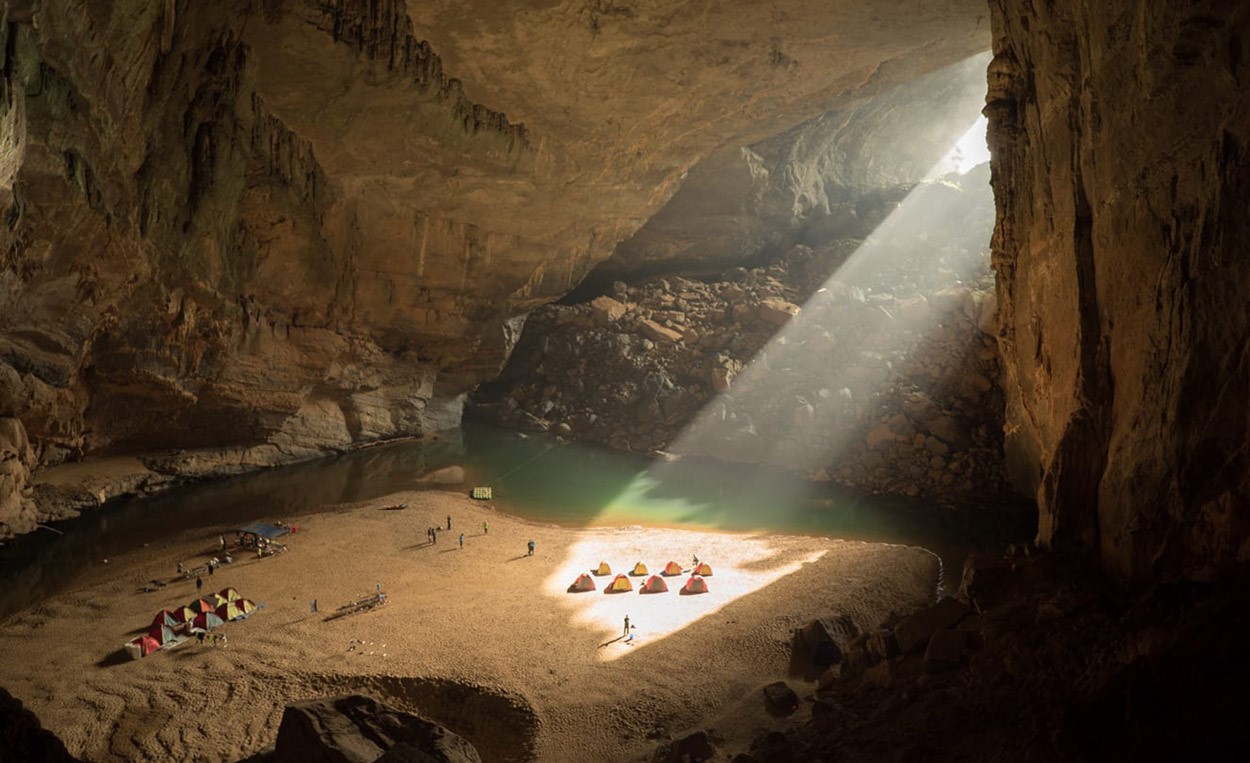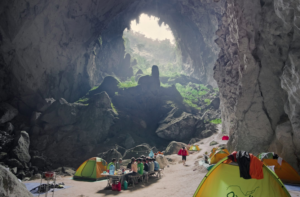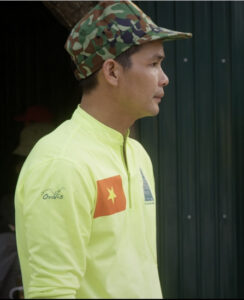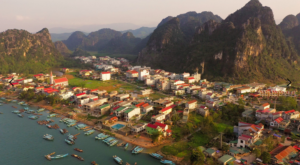Cave Doc Offers Only Partial View
Posted on March 2nd, 2022 in Entertainment, Movies, Public Discourse, Travel with 0 Comments

Light from the entrance of Son Doong shines down on First Camp, the first level spot inside the cave and the staging area for deeper exploration.
“Imagine if the Grand Canyon was discovered this week, and it didn’t belong to anyone. And there was a government that controlled it, but they were under the influences of a lot of forces. And people discovered this was going to become a major global tourist attraction. How would that go? It wouldn’t go well.”
That’s how Jonathan Drake, a 2019 visitor, frames the dilemma at Son Doong, the largest cave system on the planet and a place of spectacular beauty. It’s deep in the jungle of central Vietnam, near where aerial scenes for 2017’s Kong: Skull Island were filmed.
Huong Nguyen Thien Le, cofounder of the preservation campaign Save Son Doong, notes that the cave was isolated from the outside world and that its pristine charm has been preserved through millions of years.
“Son Doong is beautiful because of its ecosystem,” she says. “Inside this cave, there are two jungles, two rivers, one waterfall. They have even fog inside the cave that sometimes makes you forget you’re underground.”
Revealing a Natural Wonder
The documentary A Crack in the Mountain tells the story of Son Dong and its potential to change the lives of those who live nearby. The film debuted at 2022 Sedona International Film Festival, selling out two screenings and winning honors for Best International Documentary.
I want to like this film. But I expected dazzling images of this natural wonder, including its topography, layout and biodiversity. What I saw was disappointing – not that it was bad, but because it could be so much better.
However, the screenings in Sedona, Ariz., were its first before audiences. I hope that means more editing can be done, so I’ll frame my thoughts as constructive criticism.
This documentary needs to do two things: Take a deep dive into the wonder of the cave and consider the question of economic development vs. preservation. It falls short on the first and may overanalyze the second.
Director Alastair Evans has visited Son Doong eight times and took five years to make A Crack in the Mountain. He said in an SIFF interview that he’d cut a lot of footage. Still, at two hours, the film was too long by a half.
There is no question that the cave is impressive. The film shows a lot of First Camp, the first level spot inside the entrance. There are tents lined up on a subterranean beach next to a lagoon. An otherworldly rock formation rises up between First Camp and the cave entrance.
From the river to the very top, Son Doong is 449 meters at its tallest point. It is 105 meters at its widest. The film says it could accommodate a city block.
What You See, and Don’t See
I expected the camera to take us deeper into the cave, revealing what lays beyond, including the jungles, rivers and waterfall mentioned above. But other than a couple shots of cavers climbing down rocks into darkness, it didn’t. I don’t know why. Perhaps bad lighting was to blame, or maybe hazardous terrain limited the movement of film equipment. Perhaps there could be a computer simulation of what is deeper in the cave.
Instead, the documentary shows First Camp over and over again, from every possible angle – which, given the length of the film, gets pretty tedious. It also spends time showing cavers and support staff cooking and eating at the camp, which doesn’t further the narrative but adds run time.
Then the movie leaves the cave to highlight the development vs. preservation debate.
It takes viewers to Ho Chi Minh City to look at the efforts of Huong’s group to fight a plan for a tourist cable-car line into Son Doong. The documentary shows the grassroots efforts of mostly young activists to build awareness while trying not to piss off the authoritarian government in Hanoi. It starts to seem like whack-a-mole; every time the preservationists think they’ve killed the cable-car idea, wealthy business interests find a different way to revive it.
Next the documentary drills down to the local level, looking at Phong Nha, the town nearest to Son Doong, which is where the rubber hits the road in the development/preservation debate.
Residents used the income from tourism to build up their town and improve their standard of living. But, at the same time, they don’t want their neighborhood overrun by tourist hordes.
Phong Nha was a hamlet before Son Doong was discovered. It grew into a sizable town oriented toward, and financed by, tourism. Some of the local entrepreneurs earned the money to start their businesses by, literally, doing the heavy lifting for cave tours.
Near the end, A Crack in the Mountain gives its audience a quick overview of the cave’s discovery followed by top-level thoughts from the individuals interviewed throughout, such as the one at the top of this review. It also recycles many of the First Camp images from the beginning.
A Better Path
I would start the documentary with facts and photos about the cave and how it was discovered, along with the current status. That would answer questions viewers are likely to have going in, as well as buttress the later discussion about preservation.
Son Doong was discovered by a local man named Ho Kranh, who made a living foraging in the jungle. He came across the entrance while sheltering from a storm. And then, according to Howard Limbert of the British Caving Expedition, “he forgot about it because it wasn’t of any particular use to him.”
In 2005, he crossed paths with the British cavers. For a little money, he agreed to document his exploring. Over the next few years, he sought out caves again – rediscovering Son Doong in 2008 and taking the British there in 2009.
“Our initial thoughts were, it was obviously a reasonably significant cave,” Limpert says in the film. “You could hear a river flowing inside from the entrance, and there was quite a substantial breeze coming out of the cave. A substantial breeze normally would signify a substantial cave.”
He says it was a tough climb at the entrance. They didn’t see any footprints at all, but the first part of the cave floods catastrophically in the wet seasons.
“It’s possible we weren’t the first people in there, but it’s very unlikely.”
After seeing what is at stake, viewers would be better prepared to consider what the balance should be between development and preservation at Son Doong.
Since the COVID-19 pandemic, Phong Nha has shut down. Businesses are boarded up and, if it were the American Southwest, there would be tumbleweed blowing down the street.
But tourists will return to Son Doong. And Phong Nha will be the gateway for the foreseeable future.
According to a Western woman who made the trek: “Any ordinary person would never be able to find Son Doong. It’s literally in the middle of a huge canopy of mountains. From a bird’s-eye view, you would never, ever be able to see that. It’s remarkable that it was even discovered.”
Another visitor says that, from outside, “It’s very unassuming – just a pile of rocks with a hole in it.“ It takes an expedition a day and a half to two days just get there.
And therein lies the challenge.
Currently, only 1,000 tourists a year are allowed to visit Son Doong. The only way to go is on an expedition that costs about $3,000 per person.
Increasing tourism would bring an economic boost for the locals and the government. But it would require more efficient means to get people in and out. Which brings us back to the cable car. The Vietnamese government says it won’t happen – at least until 2030.
Drake, who was quoted at the start of this review, is pessimistic.
“There is too much at stake. Big players will step in,” he predicts. “I don’t have much hope that they’re suddenly going to wake up and figure out how to develop Phong Nha in a way that preserves the charm. It’ll just get trampled for money. And that’s just the way it is.”
###
Stuart J. Robinson practices writing, editing, media relations and social media through his business, Phoenix-based Lightbulb Communications.
Tags: Alastair Evans, cave, Sedona International Film Festival, Son Doong, Vietnam








COMMENTS
There are no comments yet.